This Cuban roast pork (lechon asado) is marinated in a homemade mojo marinade overnight and then roasted low and slow until it’s fall apart tender.

In Cuban Culture, roast pork, or lechon asado, is the meal served on all special occasions. Christmas, Weddings, New Year’s, you name it… roast pork is on the menu. This is a traditional recipe using a homemade mojo marinade.
This lechon recipe is for a large roast (8-10 pounds). We recommend keeping to roughly that size for these recipe instructions. I know it’s a lot of meat but trust me, it goes quickly.
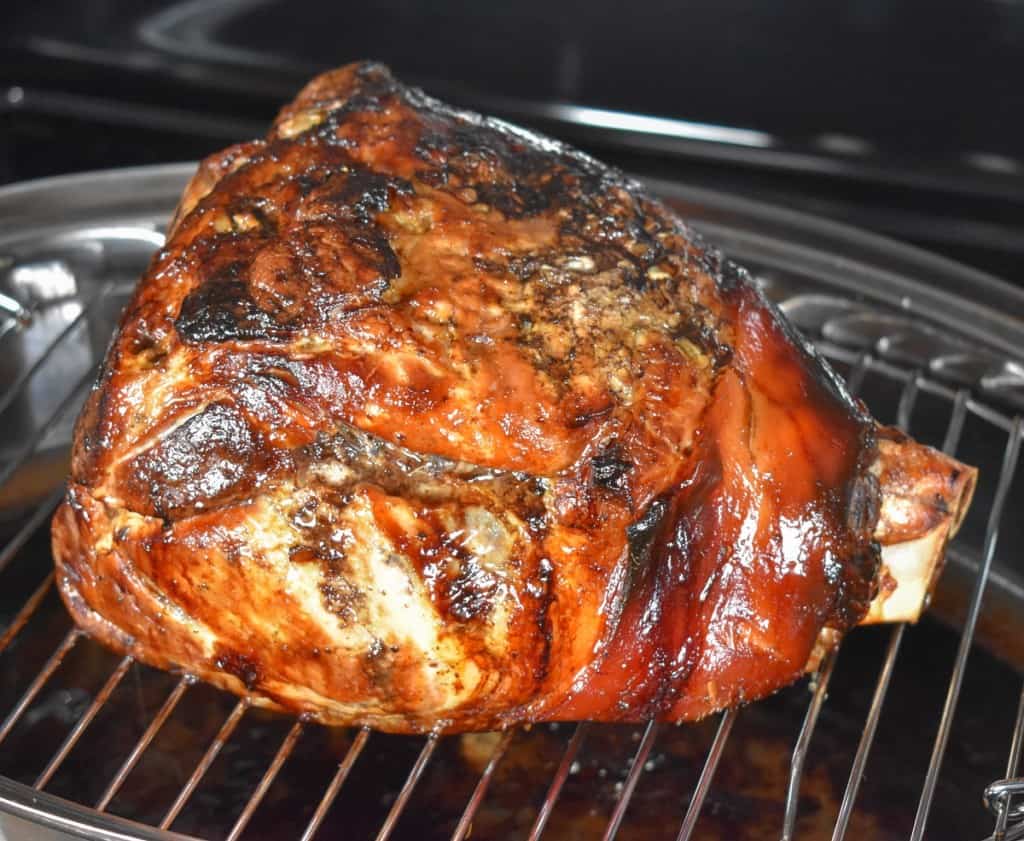
Use the leftovers to make the famous Cuban sandwich (aka a Cubano). You can also make a midnight sandwich, which is like the Cubano but with a sweet bread that is similar to brioche. For the ultimate pork sandwich make a pan con lechon, which is Cuban bread loaded with the pork and thinly sliced onions.
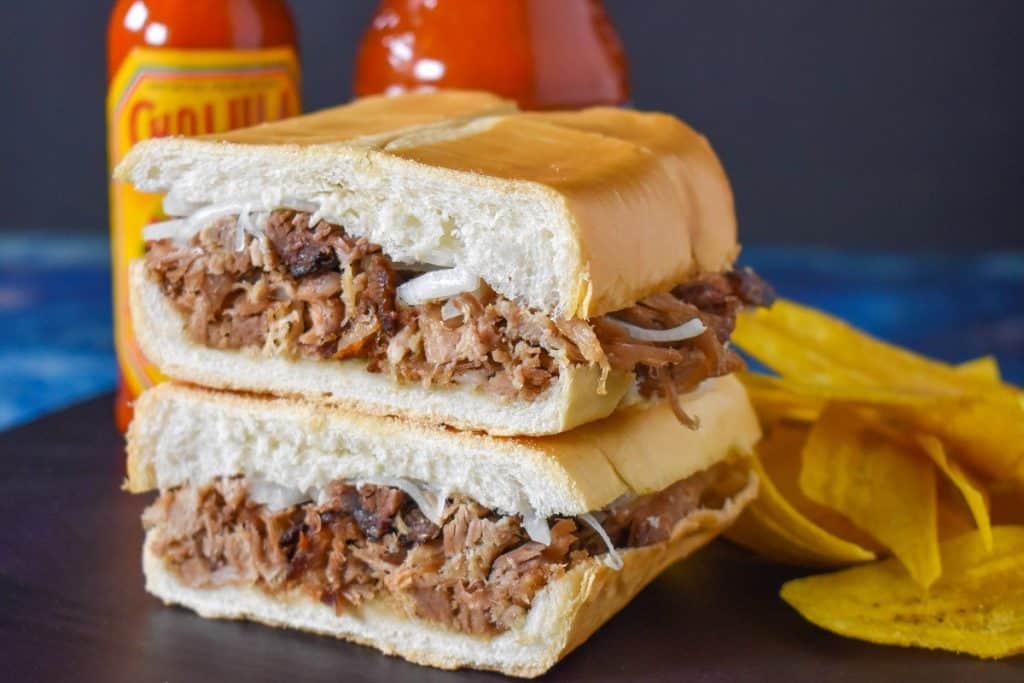
Cuban roast pork is a two-day event. The pork needs to marinate in the refrigerator overnight. Then you roast it, low and slow for hours, so make sure you plan for that.
Something else to plan for, have plenty of snacks on roasting day because while the pork is cooking your house will smell amazing. Everyone will be asking: “when will it be ready?” “Is it ready yet?” Enjoy!
This site contains affiliate links to products. As an Amazon Associate I earn from qualifying purchases.
Best cut of meat for roast pork
Lechon is Spanish for pork. For Cubans, lechon (or lechon asado) refers to roasted pork that’s marinated in mojo (a garlicky-citrus sauce). Lechon can be a whole pig or a piece of the pig that’s cooked in a pit, a Caja China (an outdoor roasting box that uses coals to cook), a traditional barbeque or an oven.
Since a whole pig won’t fit in an oven or a regular barbecue, a piece of pork is cooked instead. This is also called lechon asado. For me, the best cut of meat for roasting is the pork shoulder, also called pork picnic.
The shoulder comes from the front leg of a pig as opposed to the hind legs which are called hams. Pork shoulder is a fatty and flavorful cut of meat that works well with a long cooking time. That said, the fresh ham can also be (and is) used to make roast pork. In Spanish the pork shoulder is called paleta asada and the ham is called pierna asada.
What is mojo
Mojo is a citrus and garlic sauce that is used for pork, chicken and other meat or vegetable dishes. The citrus juice used is traditionally sour oranges (naranja agria in Spanish). Finding sour oranges can be a challenge depending on where you live. During the latter part of the year many Latin markets will stock sour oranges.
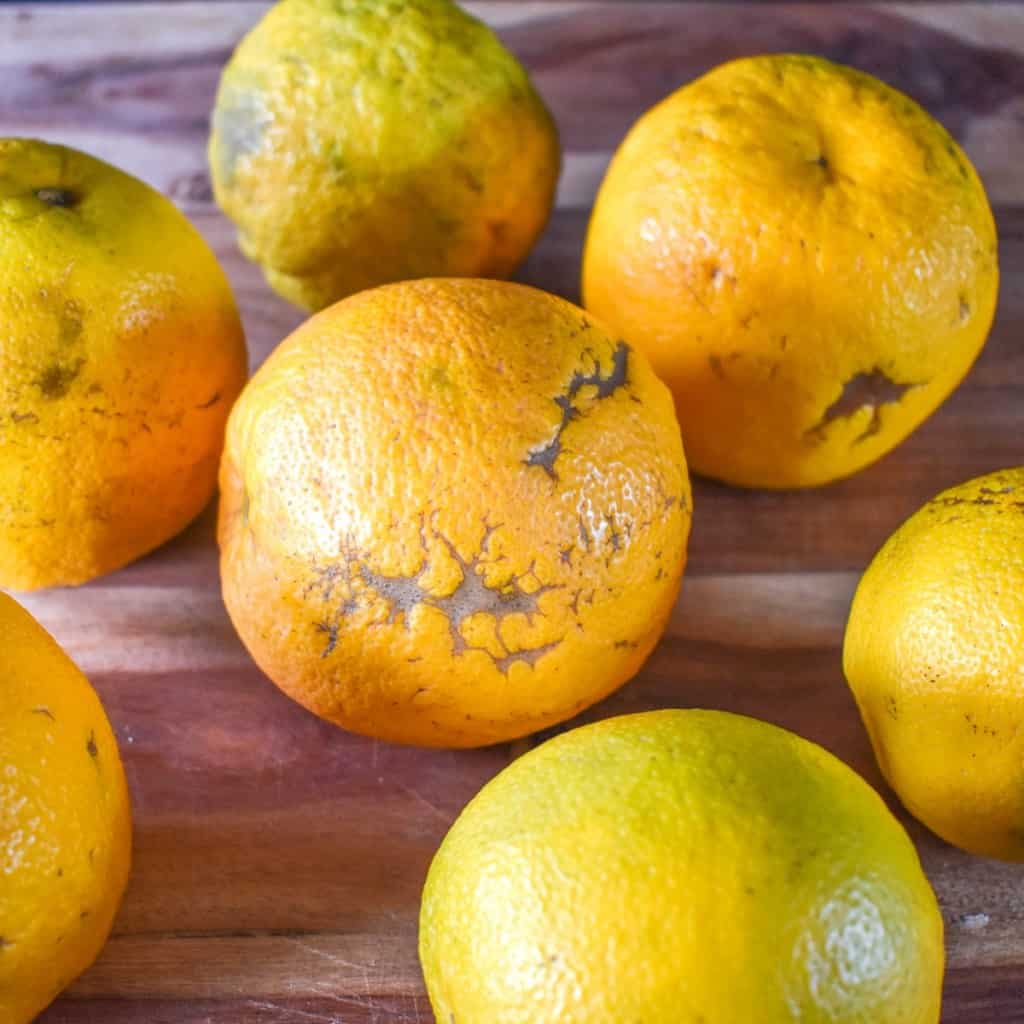
If you can’t find sour oranges, you can make a good substitute by combining orange juice (fresh squeezed is best) and lime juice at a 2:1 ratio. Two parts orange juice to one part lime juice. So, for this recipe it would be 1 cup of orange juice and ½ cup lime juice. Shake or stir well to combine.
Another alternative to consider is bottled sour orange juice. Even if it’s not the real thing, it will still get you that slightly sweet and sour taste you’re looking for. Find it in the international section of larger grocery stores and online. To learn more about sour oranges and mojo check out our mojo marinade recipe.
Ingredients
- Pork shoulder – Choose a large pork shoulder (also called pork picnic) we recommend 8-10 pounds. As a reference ours is 9¼ pounds. You can make a smaller roast, but you will have to adjust the roasting time.
- Garlic – We’ll need two heads, one for the mojo and one for the pork.
- Sour orange juice – If you cannot find sour oranges, use fresh squeezed orange and lime juice at a 2:1 ratio, or use bottled sour orange juice (naranja agria).
- Olive Oil – We used extra virgin olive oil.
- Spices – Dried oregano, cumin, bay leaf and salt (we use kosher salt).
You will also need:
- Mortar and pestle to breakdown the garlic
- Jar or container with a tight-fitting lid to keep the mojo
- Meat mallet to smash the garlic (or use the side of a large knife)
- Large pan to marinate to pork
- Large marinating or roasting bag or Plastic wrap to cover the pork while marinating
- Large roasting pan with a rack
- Aluminum Foil
- Cooking Spray
Make the mojo marinade
Peel the 2 heads of garlic. Reserve 8-10 whole garlic cloves for the pork.
Smash the remaining garlic cloves; place them on a cutting board and give them a good whack with a meat mallet or the side of a large knife.
Add the peeled, smashed garlic and 1 teaspoon salt to a mortar and pestle. Work the garlic until you break it down into small flat pieces.
Add the smashed garlic, sour orange juice, olive oil, oregano, cumin, 1½ teaspoon salt, and the bay leaf to a medium bowl or jar. Stir or shake to combine well. Cover the jar/bowl and let the marinade sit in the refrigerator for at least 1 hour, a couple of hours or overnight is better. Shake or stir well before using.
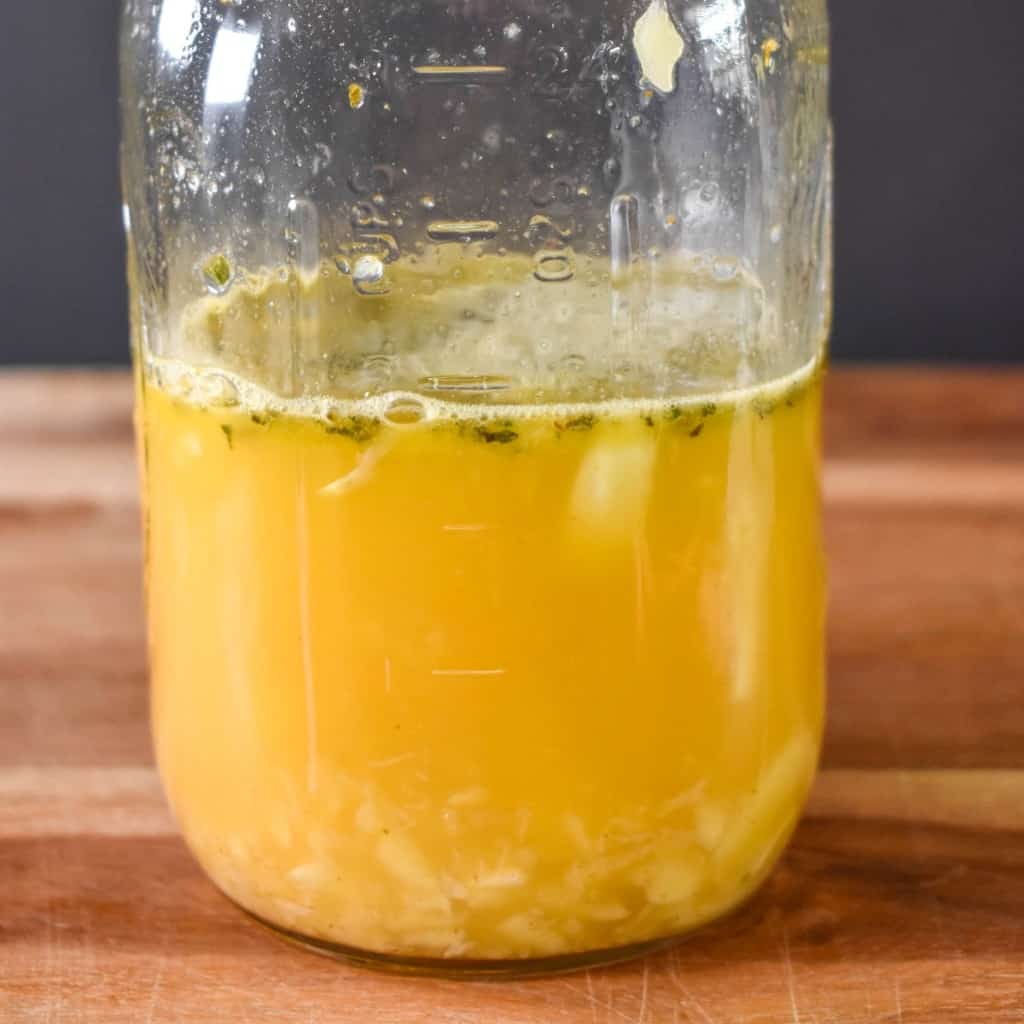
Marinate the pork
We lined the pan with a large oven bag. We found them in the foil and plastic wrap section of the supermarket (they’re made for turkeys). These bags are great because they contain the mojo and you can seal them tight with a knot.
- Place the pork in a large pan, make 8-10 small slits (about 1-2 inch deep) on the skin side and insert the reserved (whole) garlic cloves into the slits. Tip: Dip the clove in the marinade for easy insertion.
- Turn the pork over (skin side down) and make about 10-12 small slits (about 1-2 inch deep) in the meat. Use a ladle or spoon to pour the marinade into the slits you made.
- Then pour the remaining marinade over the pork. Sprinkle 1 teaspoon of salt over the pork, if desired.
- Turn the pork again so that the skin side is up, and the fleshy side is sitting in the marinade. Seal the bag by making a tight knot on the top, or cover the pan well using a generous amount of plastic wrap. Seriously, use several layers. The smell of this marinating pork is strong and will permeate the refrigerator. While the pork roast marinade is delicious, I don’t want my refrigerator smelling like it for days.
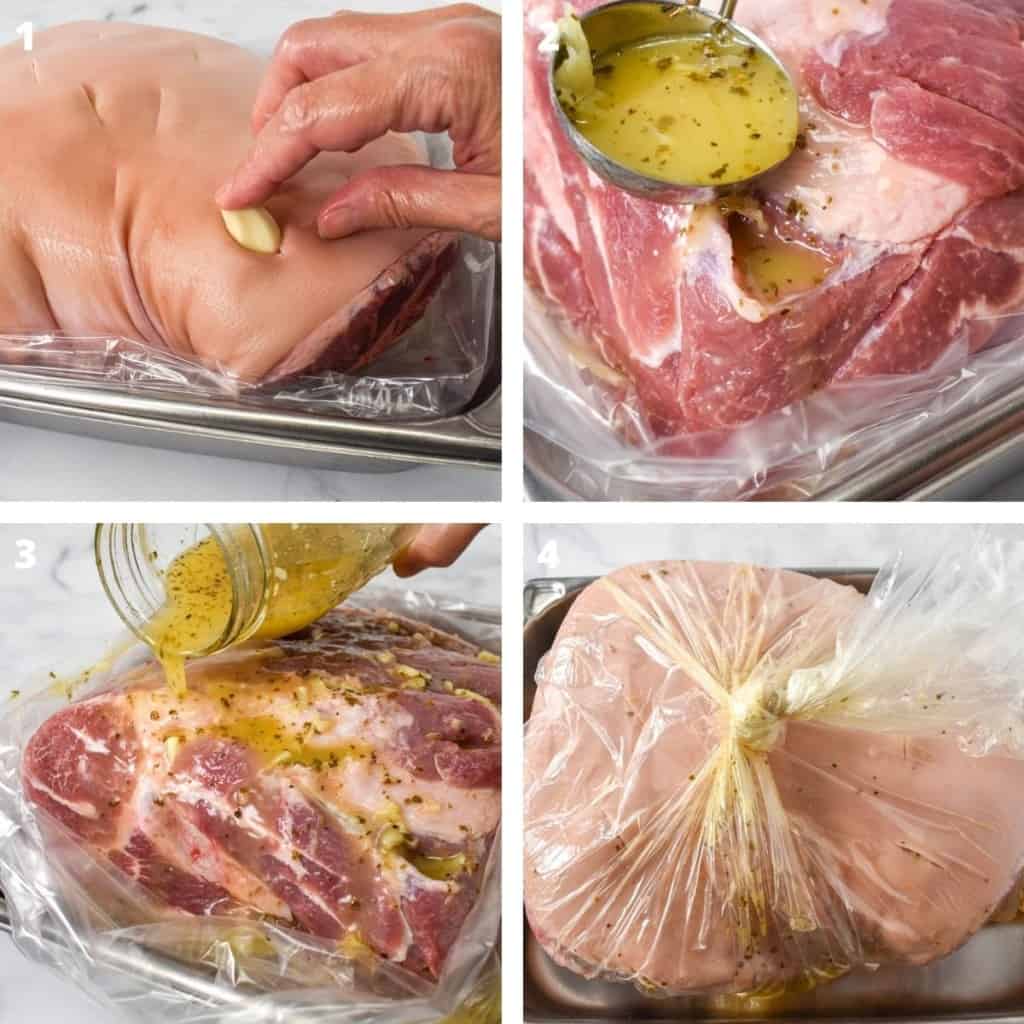
Marinate the Cuban roast pork in the refrigerator overnight.
Roasting instructions
Remove the pork shoulder from the refrigerator 30-45 minutes before roasting (providing that it’s cool in your kitchen).
Preheat oven to 325°F
Use a roasting pan that has a rack so the pork shoulder is not sitting on the bottom of the pan.
Lightly spray the rack of the roasting pan with cooking spray. Place the pork on the rack, skin side down. The marinated pork will be a grayish color, that’s normal; it’s the citrus working on the meat.
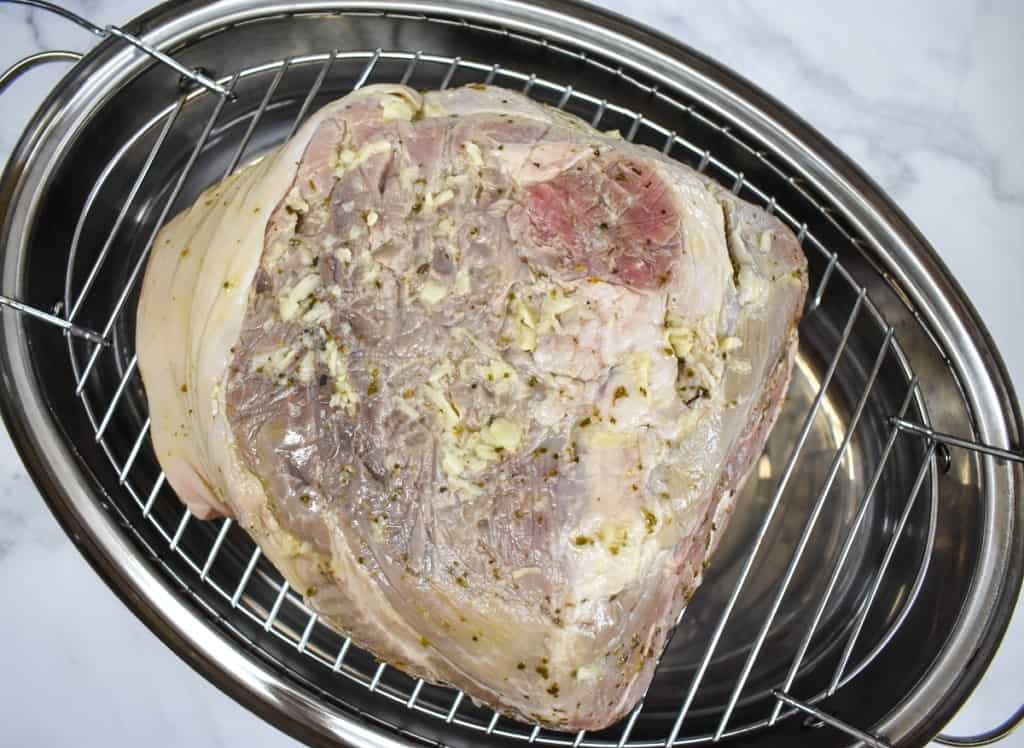
Brush any loose pieces of garlic off the pork. They will start to burn quickly. Also, pour just a little bit of water in the bottom of the roasting pan. You’ll have to add a little more during the roasting time too. The drippings and garlic on the bottom of the pan will start to burn and smoke. The water keeps this in check. Discard leftover marinade.
Roast the pork for a total of 6-7 hours until the internal temperature reaches at least 170° F and the meat has pulled away from the bone on one end. Check the temperature at several different spots. About 1½-2 hours into the roasting time tent the pork. Take a piece of aluminum foil (roughly the size of the pork shoulder) and loosely cover. Just place it on top, don’t wrap it.
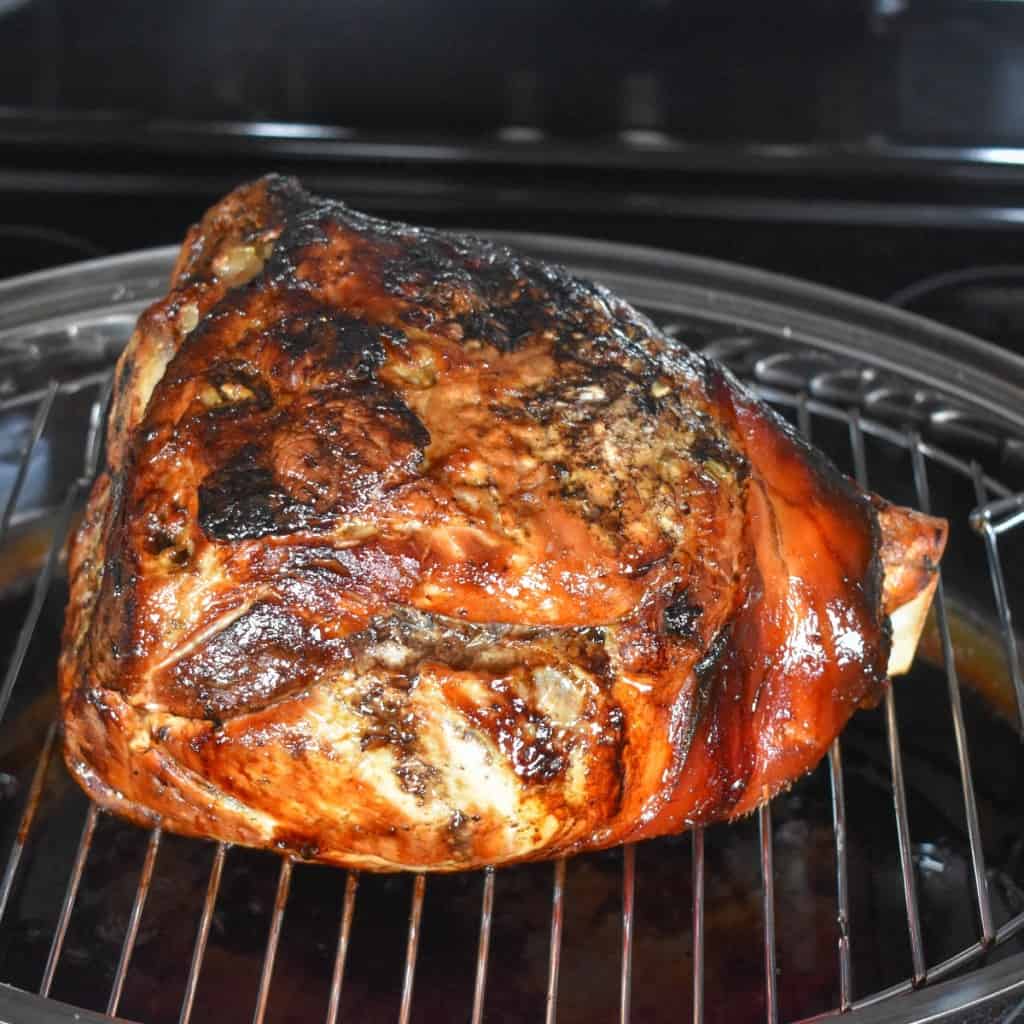
Crisp the skin
You can crisp the skin of the pork a little at the end, if desired. Remove the pork from the oven and carefully flip it over so it’s skin side up. Be very careful during this step because the roast is heavy and hot!
Fill a bowl or cup with water and add a generous amount of salt (about 1 tablespoon for 1 cup of water) stir. Drip a little of the salted water on the pork roast and brush it all over the skin. Repeat several times.
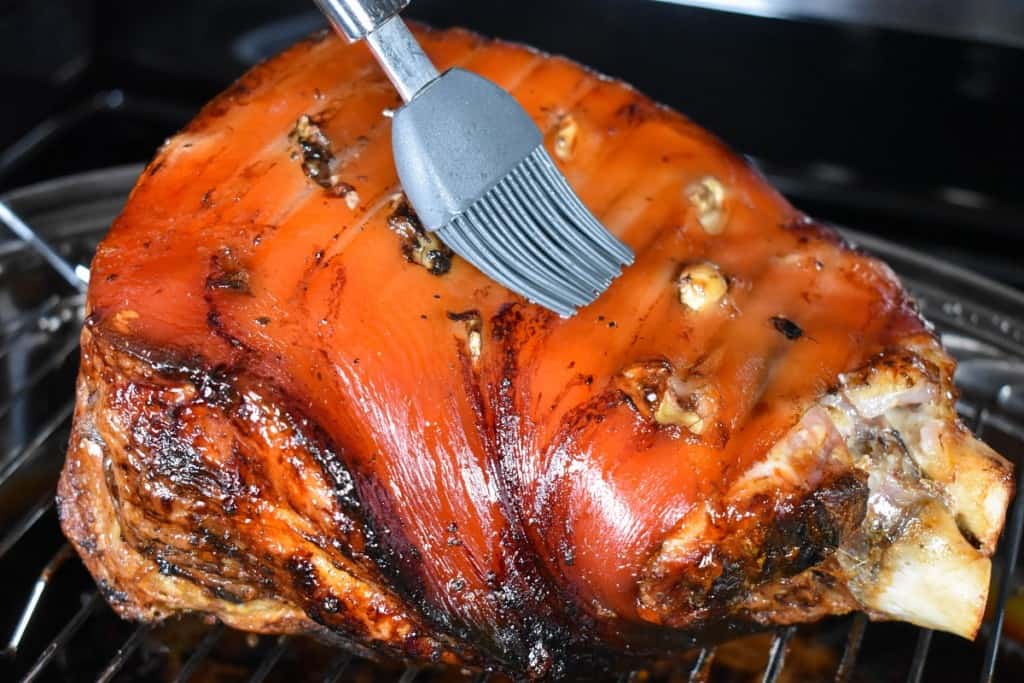
Make sure the pork isn’t sitting too close to the heat element. Move the rack down if you need to. Switch the oven to the low broiler setting.
Very Important Cook’s Note: Do not leave the oven’s side until you finish this step. Turn on the oven light and look in every minute or so. It will only take 2-4 minutes. The skin will crisp and brown quickly, it will go from perfectly golden brown to burnt in minutes, if not seconds.
Once the skin is bubbling and it may even start to crackle, carefully remove the pork from the oven, cover it loosely with a piece of foil and allow it to rest at least 20 minutes before carving.
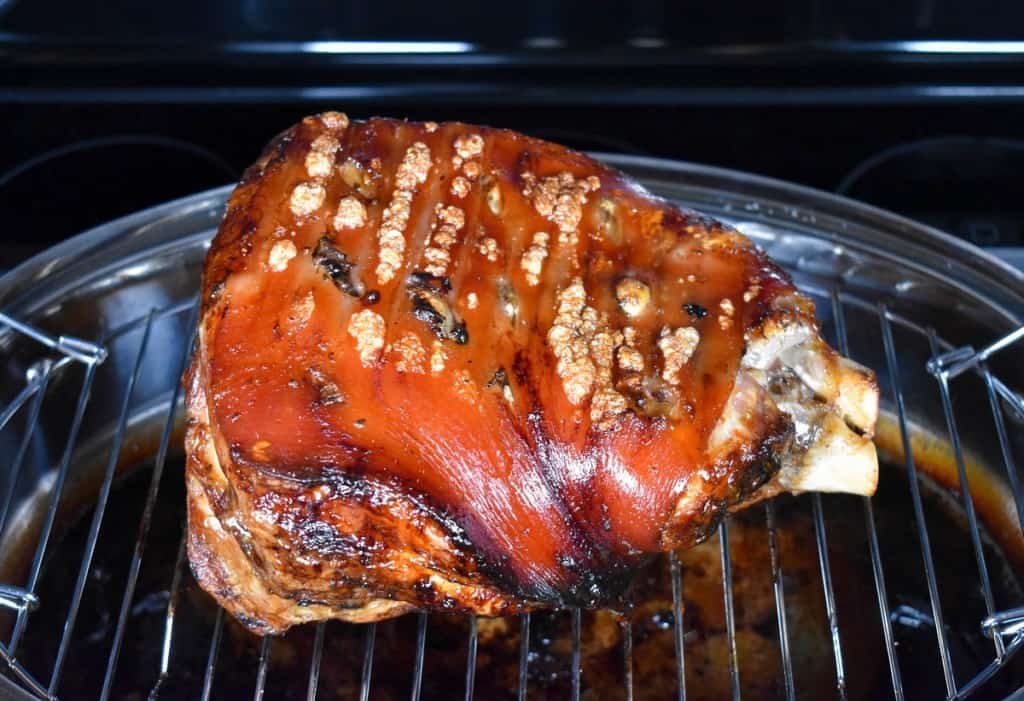
Side dish suggestions
Traditional side dishes served with lechon include the classic combination of white rice and black beans. For special occasions you’ll find yuca con mojo or fried yuca (yuca frita) served alongside the roasted pork. And of course, fried green plantains (tostones) or fried sweet plantains (maduros) are always a welcome side.
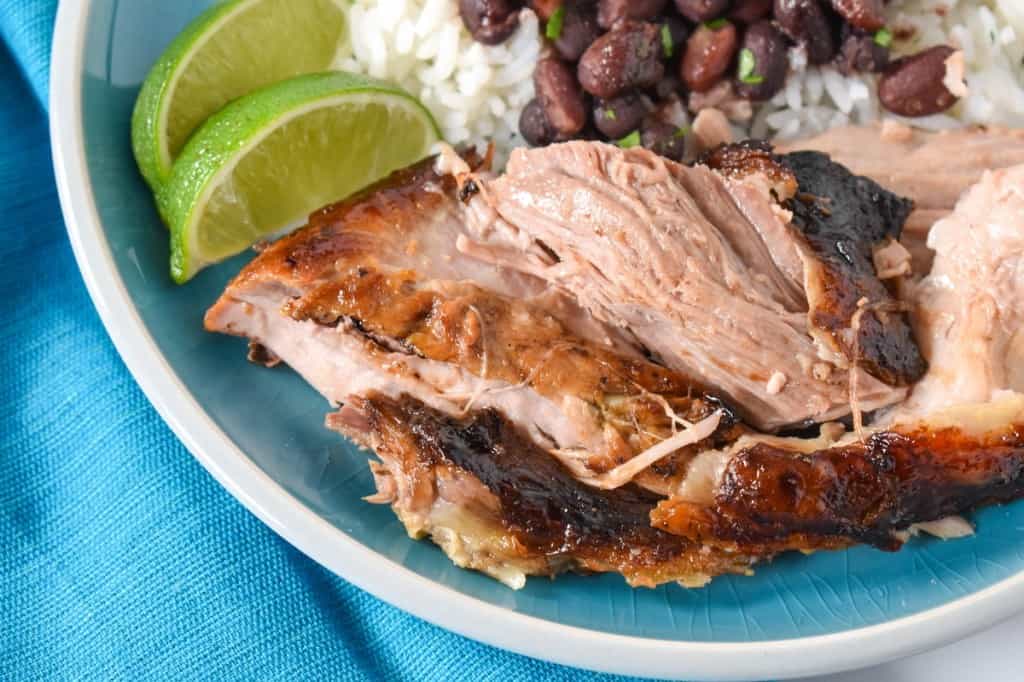
Storing and reheating
Refrigerate any leftover roast pork in an airtight container for 3-4 days. We take the pork off the bone so it’s easier to store.
You can also freeze the leftovers in an airtight container for up to 3-4 months.
The best way to reheat the lechon is in a skillet. Add a little bit of oil to a large skillet (we use non-stick) over medium heat. When the oil is hot, add the pork and cook for a few minutes turning occasionally until heated through.
You may also like:
- Ropa Vieja
- Arroz con Pollo
- Bistec de Palomilla
- Cuban-style Red Beans (frijoles colorados)
- Vaca Frita
📖 Recipe
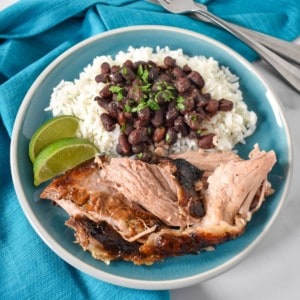
Cuban Roast Pork (Lechon Asado)
Ingredients
- 8-10 pound Pork Shoulder also called pork picnic (ours is 9¼ pounds)
- 2 Heads of Garlic peeled - divided (1 head for the mojo marinade and 1 head to insert in the pork)
- 1½ cups Sour Orange Juice how many oranges to use will depend on how large and juicy they are (about 3 pounds)
- 2 tablespoons Olive Oil
- 1 teaspoon Dried Oregano
- ¼ teaspoon Cumin
- 1 Bay Leaf
- 2 tablespoons Coarse Salt divided (1 teaspoon to break down the garlic, 1½ teaspoon for the mojo marinade, 1 teaspoon to sprinkle on the pork, about 1 tablespoon for the water to crisp the skin at the end)
Instructions
- You will also need: Mortar and pestle, a jar or container with a tight-fitting lid, meat mallet to smash the garlic (or use the side of a large knife), mesh strainer (to catch the seeds of the oranges), a large pan to marinate to pork, large marinating or roasting bag (optional) or plastic wrap to cover the pork while marinating, large roasting pan with a rack, aluminum foil to tent the pork, and cooking spray.
Make the mojo marinade
- Peel the 2 heads of garlic.
- Reserve 8-10 whole garlic cloves for the pork.
- Smash the remaining garlic cloves; place them on a cutting board and give them a good whack with a meat mallet or the side of a large knife.
- Add the smashed garlic and 1 teaspoon salt to a mortar and pestle. Work the garlic until you break it down into small flat pieces.
- Add the smashed garlic, sour orange juice, olive oil, oregano, cumin, 1½ teaspoon salt, and the bay leaf to a medium bowl or jar. Stir or shake to combine well.
- Cover the jar/bowl and let the marinade sit in the refrigerator for at least 1 hour, a couple of hours or overnight is better. Shake or stir well before using.
Marinate the pork
- Line a large pan with the roasting bag (if using). Place the pork in the pan.
- Make 8-10 (as many garlic cloves) small slits (about 1-2 inch deep) on the skin side of the pork.
- Insert the reserved whole garlic cloves into the slits. Dip the clove in the marinade to make inserting them easier.
- Turn the pork over (skin side down) and make about 10-12 small slits (about 1-2 inch deep) in the meat.
- Use a ladle or spoon and start pouring the marinade into the slits you made.
- Then, pour the remaining marinade over the pork. Sprinkle another 1 teaspoon of salt over the pork (if desired).
- Turn the pork, now it should be skin side up. We want the fleshy side sitting in the marinade.
- Seal the bag by making a tight knot on the top, or cover the pan well using a generous amount of plastic wrap.
- Marinate the pork in the refrigerator overnight.
Roast
- Remove the pork from the refrigerator 30 – 45 minutes before roasting (providing that it’s cool in your kitchen).
- Preheat the oven to 325°F
- The marinated pork will be a grayish color, that’s normal; it’s the citrus working on the meat.
- Lightly spray the rack of the roasting pan with cooking spray.
- Place the pork on the rack, skin side down.
- Brush any loose pieces of garlic off the pork. They will start to burn quickly.
- Pour a little bit of water in the bottom of the roasting pan. You’ll have to add a little more during the roasting time too. The drippings and any garlic pieces on the bottom of the pan will start to burn and smoke. The water keeps this in check. Discard leftover marinade.
- Roast the pork for a total of 6-7 hours until the internal temperature reaches at least 170° F and the meat has pulled away from the bone on one end. About 1½-2 hours into the roasting time tent the pork. Take a piece of aluminum foil (roughly the size of the pork shoulder) and loosely cover. Just place it on top, don’t wrap it.
Crisp the skin (if desired)
- Remove the pork from the oven and carefully flip it over so it’s skin side up. Be very careful during this step as the roast is heavy and hot!
- Fill a bowl or cup with water and add a generous amount of salt (about 1 tablespoon for 1 cup of water), stir. Drip a little bit of the salted water on the pork roast and brush it all over the skin. Repeat several times.
- Make sure the pork isn’t sitting too close to the heat element. Move the oven rack down if you need to. Switch the oven to the low broiler setting.
- Very Important Cook’s Note: Do not leave the oven’s side until you finish this step. Turn on the oven light and look in every minute or so. It will only take 2-4 minutes. The skin will crisp and brown quickly, it will go from perfectly golden brown to burnt in minutes, if not seconds.
- Once the skin is bubbling and it may even start to crackle, carefully remove the pork from the oven, cover it loosely with a piece of foil and allow it to rest at least 20 minutes before carving.
Video
Notes
Nutrition
The nutritional information above is computer generated and is only an estimate. There is no guarantee that it is accurate. This data is provided as a courtesy for informational purposes only.



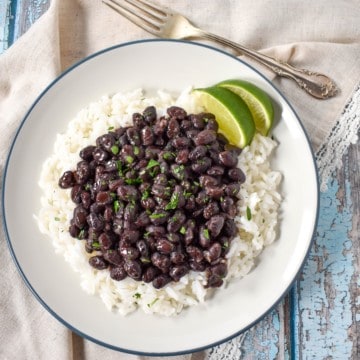


Nelson Masson
Hi Elizabeth, So I am cuban american and my family makes a whole pig in a "caja china" every 24th of december but this year due to covid we are not getting together so I am making one of these for the first time at home. I had few questions. 1. Do I need to put the pork on a rack in the roasting pan? I have a disposable roasting pan and dont have a rack. 2. The roasting time is 7-8 hours total? and 3. Do you recommend basting it while it cooks? Thanks again!
Elizabeth
Hi Nelson,
1. We use a roasting pan with a rack to keep the skin off the drippings and the water (we recommend adding water to the bottom of the pan to keep the drippings from smoking). I’ve never lechon without a rack so I cannot speak to the results.
2. For a large roast (like an 8 to 10 pounder) yes it is.
3. No, I don’t baste. I try to open the oven as few times as possible, plus the drippings are mixed with water to prevent smoking.
Good luck, I hope it turns out great, Feliz Noche Buena!
Cam Kimler
This sounds fabulous but, the recipe instructions for crisping the skin are only if you have an electric stove with the broiler and heat element in the top. My stove is natural gas and my broiler is barely deep enough for making toast. What about removing the roast a few minutes before it reaches the 170 temp and brushing it with the salt water then putting it back in the oven to finish cooking? Or, can the entire roast be cooked outside in a smoker?
Elizabeth
Hi Cam,
I’m afraid that won’t work, the salt itself does not crisp the skin, it’s the direct high heat on it. For the smoker, I don’t own one but that sounds amazing! You will have to consult another recipe however. Thanks for stopping by.
Yvette
Hello Elizabeth, I am attempting this recipe this weekend and my pork shoulder has no skin and is a little under six pounds. Do you recommend lowering the heat? I plan on cooking it about 20 or so minutes a pound. And when should I make the foil tent? Maybe after 30 minutes?? Any advice will help as I am cooking for a Cuban family. Do not want to disappoint! 😉
Thank you,
Yvette
Elizabeth
Hi Yvette,
You’re going with a smaller roast and I’ve never made a lechon without the skin and the layer of fat that goes under it, but I’ll do my best to help.
Lowering the temperature – we’re already cooking at a low temperature; I wouldn’t lower it any further.
Tenting – tent the pork when it start browning (use the oven window with the light on to peek in, try to open the door as little as possible)
Cooking time – this is where you are going to have to keep an eye on it. The internal temperature needs to be at least 170 degrees Fahrenheit. A good sign that it’s done is that the meat will pull away from the bone. Look at the pictures in the post and you can see what that looks like.
Also, go through the comments section, several people have made smaller roasts, etc. and they share their experience. Good luck! Let me know how it goes.
Mark Beaudry
I made this just this past Sunday and made one big mistake: my roast was 7 1/2 lbs., not the 10 in the recipe and I neglected to adjust the time for the smaller size. It was beyond done in only 5 hours, the bone sticking right out. Interestingly it still had enough juice it it to be palatable. I would also recommend that a lot of the fat cap be trimmed of first. Being cooked skin, or fat side down, the fat doesn't really baste the meat anyway- there's enough fat through the meat to do that. Also, very good tip about adding water. I had to do it several times to keep the smoke down, which it did quite effectively. Other than that it was really good and I'll try it again.
Elizabeth
Hi Mark,
I’m glad it worked out, thanks for stopping by.
Marie Hoffman
Hi Elizabeth i made this and let me tell you it was so delish my family loved it .My house smelled amazing even my neighbor was telling how good it smelled. I made him a plate he was so happy Thank u very much for sharing your recipe i will definitely make this again
Elizabeth
Hi Marie, thank you and it’s my pleasure! Yes, you can absolutely smell it outside from our house too when we make it. I’m really happy you liked it!
Shyla
Anyway to start the cooking process one day and finish the next? Maybe 5 hours of roasting the day before then an additional couple hours before serving?
Elizabeth
Hi Shyla. Thank you for your question. For food safety purposes the pork roast needs be fully cooked. The long roasting time ensures that the meat is not only properly cooked but fall apart tender. Thank you for stopping by!
Stephanie
Hi Elizabeth! I’m making this tomorrow. I have it marinating in the fridge now. My roast is just under 6 lbs. Do you think I should cook it for 3-1/2 to 4 hours based on your cooking time? Thank you so much! It was a real treat to find this recipe. My parents are British and we have had roast pork with crackling for many Christmas dinners over the years. I’m excited to try this variation on the traditional roast. Thanks so much for recipe!!
Elizabeth
Hi Stephanie,
See how it looks after 3 hours. If the outside looks golden then take the internal temperature and gauge the remaining cooking from there. The internal temperature should be at least 170°F. This is assuming you are using a pork shoulder- with the skin on (which is nice and fatty so the meat will not dry out) and cooking at 325°F.
Also, look for the meat to pull away from the bone. The bone should be visible, that’s another good sign that it’s done. Look at the picture in the post and you can see the bone on the right side.
I hope this helps and good luck! Let me know how it turns out.
Ruth Cotter
I’ll be making this for Christmas. Can I make a sauce from the roasting juices?
Elizabeth
Hi Ruth,
I don’t use the drippings because during the cooking time a little bit water has to be added to the bottom of the roasting pan (a few times) to keep the drippings from smoking/burning. So, since the drippings are combined with the water I don’t use them.
Lita Lee
I made a cilantro pesto not with the drippings, but with the leftover mojo after I scraped it all off. I cooked it, cooled, and blended it my Vitamix with a bunch of fresh cilantro. Keeps in the fridge for a week, or freeze in an ice cube tray.
Kelly
Hello I am so excited to make this recipe!! However my broiler is under my oven. There is no way that the Pork would fit in there.
Any suggestions?
Thank you so much for all your help.
Kelly
Elizabeth
Hi Kelly,
I’m afraid I don’t have any suggestions. If you do think of something please leave a note that might help someone else out!
Julie Trueba
If your broiler element Is under your oven just heat the oven to 400* and finish the roasting for 15-20 minutes to crisp the outside of the meat.
Dona Fellows
Couple of questions I should have asked before. What size pork roast is this recipe based on? Also, I'd like to be able to thin slice this for cuban sammiches. How much should I adjust the c ooking time? Just to the internal temperature recommended by the USDA? I'm sure I'll have more questions before I'm ready. Thanks!
Elizabeth
Hi Dona. This recipe is meant for a large roast - 10 pounds is ideal for the cooking time suggested. I’ve made 8 pounds and just kept an eye on it. Anything larger or smaller will need cooking time adjustment.
Dona Fellows
Can a broiler pan with the broiler rack be used for this recipe? I don't often have the need for a big roaster with a pan, so this would be an awesome alternative I think.
Elizabeth
Hi Dona. You need a pan that’s large enough to fit the roast and will elevate it so it’s not sitting in the drippings. Speaking of drippings, there needs to be enough room in the bottom of the pan to add water to keep the drippings from smoking.
Bernadette
Hello
I just made this recipe. It’s still in the oven but I have a couple of questions. I actually had 3 small roasts that only equaled about 7 pounds. I had todo the 2:1 ration of oranges & limes. Checking the roasts For internal temp of 170 degrees I took 1 out. Great flavor but it’s not tender. Did I do something wrong? Also the roasts I had did not really have a skin side.
Elizabeth
Hi Bernadette,
I’m sorry your roasts were not tender. This recipe was created and tested for a large pork shoulder (8-10 pounds) this includes the cooking time and the internal temperature. The skin is also important, because there is a layer of fat under it that contributes to the moisture. I am glad you enjoyed the flavor though. Thank you for stopping by!
Amanda Hicks
Can you tell me why skin side down? Every other pork I’ve roasted has called for skin side up, so it melts and bastes the rest of the meat as it cooks. Just curious!
Elizabeth
Hi Amanda,
I have to tell you that this is a family recipe. I make it exactly as my mom taught me, haven’t changed a thing! Sadly, I can’t ask her why, but I suspect she learned from a family member anyway. While I can’t tell you why we do it this way, I can tell you what happens. The meaty underside becomes browned, it almost caramelizes. It’s rich and flavorful. I don’t think that would happen if it’s on the bottom. Now, after the roast is done, we do flip it skin side up and toast the skin. Thank you for stopping by and for your thought provoking question! If you do make the roast pork drop me a note and let me know how it turned out!
Amanda Hicks
Made today. It was delicious!
Elizabeth
That's fantastic! I'm really glad.
Nadia
I'm looking to make this tomorrow. Do you know if the meat freezes well? I'm a fan of anything I can freeze and bring out later for a quick lunch / dinner. Thanks
Elizabeth
Hi Nadia. I have not frozen the pork meat so I can’t speak to the taste and texture. I do know that the pork will keep nicely for a couple of days in the refrigerator, kept covered in a container. My favorite way to heat it up is in a skillet with just a little oil. We will usually make sandwiches the next day with the leftovers. Thanks!
Elizabeth
What would be the cook time for 3 lbs of roast
Elizabeth
Hi. I've haven't personally tested the cooking time for a smaller roast, but the general consensus is 20-30 minutes per pound (depending on the pork cut). Of course, always making sure the meat is up to temperature.
Paul Melgoza
I made this today, and it turned out excellent. I would recommend when marinating the meat to use either a small cooking bag (I used turkey sized, which was far too large) or a large bowl or even placing a cooking bag with the meat inside of a bowl in order to more evenly marinate the meat. I used 2 large silicone kitchen tongs to rotate the meat on the rack for crisping, and they worked well. Kitchen forks might also work, but the meat is so tender that it may be torn apart by the forks. Also, make sure to add 1C of water to the roasting pan every hour or so. I added 1.5C when I put the pan into the oven, and 2 hours later I had scorched garlic in the pan.
Elizabeth Rodriguez
Hi Paul. I am really glad you enjoyed it. Thanks for adding the extra tips!
Eddie
I've made it 3 times and the skin is always super crispy.
Diana
OMGoodness! This will be along side our turkey this Thanksgiving! While most love a good turkey on the holiday, it is not on my favorite list! This looks delish!
Elizabeth Rodriguez
Thanks Diana! I know what you mean. We stick to the traditional turkey for Thanksgiving but everything else, Christmas, New Year's, Mother's day... It's Lechon! Enjoy and Happy Holidays!!
Connie
You call for "sour" oranges. Are these a special type of orange? If they aren't available, what would you recommend as a substitute?
Elizabeth Rodriguez
Hi Connie. Yes they are a special type of orange; they’re bitter and not as pretty. The color is not very vibrant, they’re greenish-orange and the skin is bumpy, not smooth. Definitely don’t want to snack on one! They’re not available everywhere, or throughout the year. A good substitute is to combine fresh orange juice and lime at a 2:1 ratio. So for the mojo in the roast pork you would use 1 cup of orange juice and ½ cup lime juice and stir or shake well to combine. Take a look at our mojo marinade recipe, there is step by step instructions (including the substitute for sour oranges) and pictures.
Carol
This looks wonderful but how do you recommend serving this? Sliced/chunks with sides, sandwiches?
Elizabeth Rodriguez
Hi Carol. Here are some ideas...You can slice or chop it into chunks and serve it with white rice and black beans. Or, you can go the sandwich route and shred the pork (the underside especially shreds up nicely) and serve it with paper thin onions, to make a pan con lechon, or slice the pork thin and make a Cuban sandwich with ham, Swiss cheese, pickles and a little mustard. With the sandwiches, make sure to press/panini them. Hope that helps!